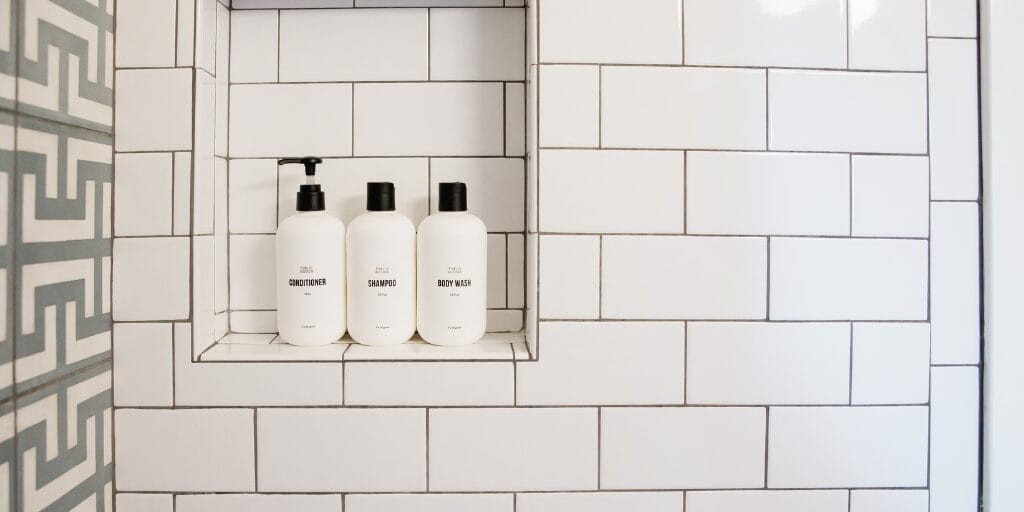Renovating a bathroom is a really exciting time, but when it comes to bathroom tiling, the question of how many tiles you’ll need is often tricky. Overestimate, and you’re left with excess material, but underestimate, and you risk halting your project halfway through. So, how do you get the balance just right?
Why the old tile calculating method doesn’t always work
The traditional approach was straightforward:
- Measure the area of the walls or floor to be tiled.
- Deduct areas for doors, windows, and features like a bath panel.
- Add 10-15% for cuts and wastage.
While this method gave a general idea, modern tiling trends have rendered it a tad less reliable. Why? Because tile sizes have grown. Oversized tiles, while stunning, introduce unique challenges when it comes to working out exactly how many you need. So, whilst this old method gives a ballpark figure it doesn’t account for modern wastage factors.
Measure your bathroom carefully
Before anything else, measure your bathroom precisely. Take into account:
- Floor area: Length × width.
- Wall area: Multiply the height of each wall by its width, then add them up.
- Subtract fixed features: Deduct the areas occupied by doors, windows, and built-in furniture. You should avoid deducting windows entirely though if they have reveals, as you’ll likely need those tiles for the reveals themselves.
Remember, almost no room is perfectly square, and not all ceilings are level, so don’t just assume that’s the case. The simplest way to lay tiles is to centralise the layout on a wall. Depending on your space, this might mean centring a full tile or the grout joint between two tiles. Choose the layout that gives you the largest cuts at the edges for a polished finish. However, you may need to adjust based on features like window reveals, doors, or fixed furniture to avoid small, awkward cuts.
Factor in tile size and layout
Hopefully it won’t come as a surprise that the size of your chosen tiles directly affects the quantity needed! Here’s why:
- Smaller tiles: These fit well into tighter spaces but require more grout, which can make the room look busier.
- Large-format tiles: Popular for their sleek, modern look, these can lead to more significant wastage. A single miscut can cost you a large portion of the tile, especially around tricky edges or uneven surfaces.
The two-tile rule
A useful guideline for walls is to plan your layout around two full tiles in the centre. This minimises the need for small cuts at the edges, creating a more symmetrical and polished look. But be prepared for higher wastage at the edges, especially if your room dimensions don’t align neatly with the tile size.
Ceiling height and room shape matter
As we mentioned above, most people focus on floor dimensions but forget to account for variations in ceiling height. Even a slight difference can mean you’ll need extra tiles to fill unexpected gaps. Similarly, irregularly shaped rooms or alcoves can complicate calculations, leading to additional wastage.
How many extra bathroom tiles should you buy?
It’s always better to have more tiles than you think you’ll need. The idea of adding a percentage for wastage isn’t always helpful. Instead, calculate how many tiles you’ll need for the width and height of the room, and then add some extra tiles for each wall. This approach ensures you’re covered for mistakes, adjustments, and future repairs.
Pro tips for minimising wastage
Plan your layout carefully
Take some time to discuss the tile arrangement with your installer before placing your order. They may suggest adjustments to reduce cuts and get the most for your money.
Store spares
Don’t forget to keep a few extra tiles for future repairs or touch-ups! Styles change constantly, and a perfect match might not be available years later.
Consider panels
In some cases, wall panels can be a practical and maintenance-friendly alternative to tiles, especially in shower areas. We’ve put together a whole blog on wall panels, so you can take a look at that here to work out if they’re right for you and your home.
Final thoughts
Tiling your bathroom is a big investment, so it’s worth taking the time to calculate your needs properly. By planning carefully, considering the specifics of your room and tile choice, and allowing for some extra material, you can avoid costly delays and wastage. Whether you’re opting for large tiles or classic smaller ones, following these tips will make sure that your project is as smooth and stress free as possible, whilst giving you results you’ll love for years to come.
Need helping renovating your bathroom? Talk to our friendly team, we’d love to help you create the bathroom of your dreams!

